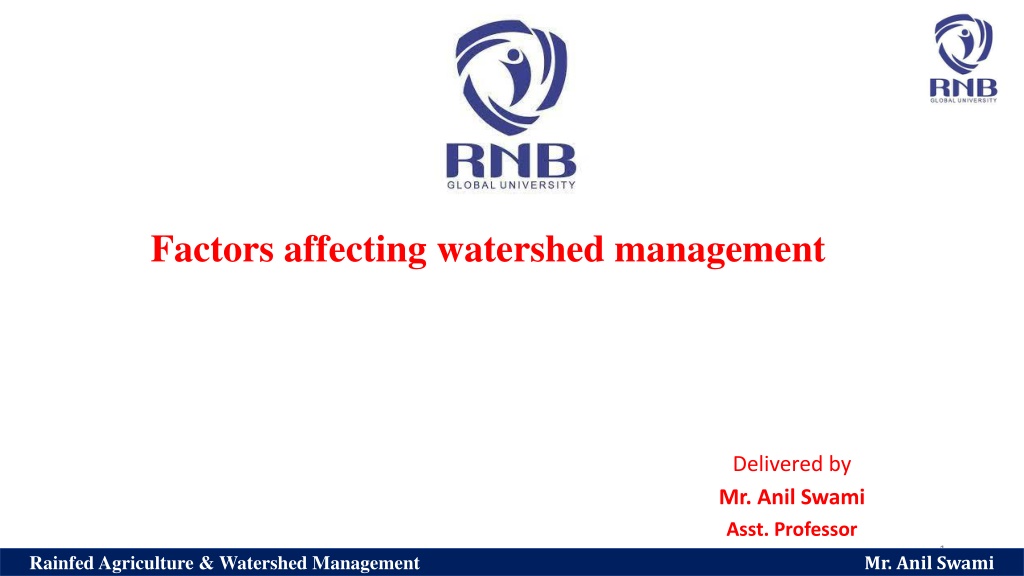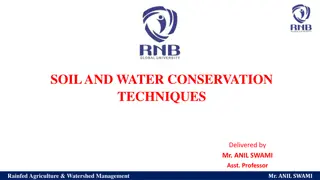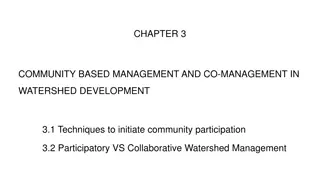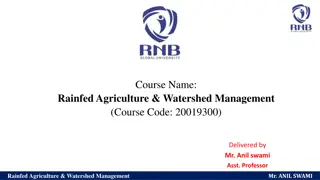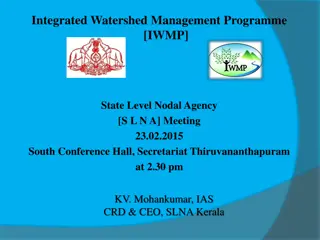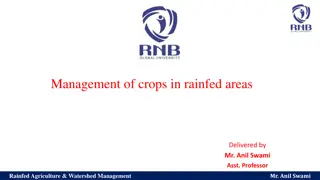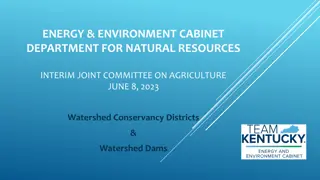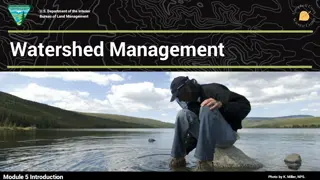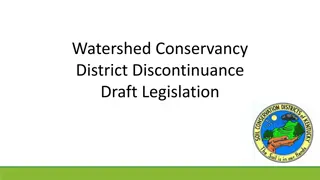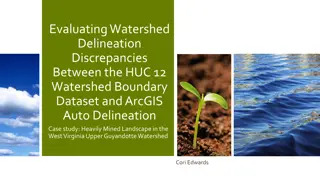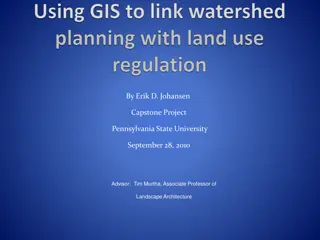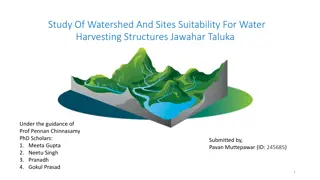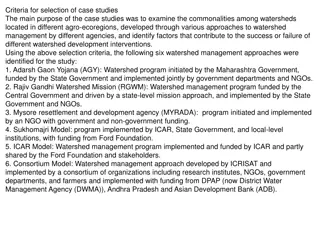Factors Influencing Watershed Management Explained by Mr. Anil Swami
Mr. Anil Swami, an Assistant Professor specializing in Rainfed Agriculture & Watershed Management, discusses the factors affecting watershed management. These factors are categorized into watershed characteristics, climatic characteristics, land use patterns, social status, and organization. Watershed characteristics such as size, shape, and topography play a crucial role in managing water resources effectively. Understanding these factors is essential for sustainable watershed management practices.
Download Presentation

Please find below an Image/Link to download the presentation.
The content on the website is provided AS IS for your information and personal use only. It may not be sold, licensed, or shared on other websites without obtaining consent from the author. Download presentation by click this link. If you encounter any issues during the download, it is possible that the publisher has removed the file from their server.
E N D
Presentation Transcript
Factors affecting watershed management Delivered by Mr. Anil Swami Asst. Professor 1 Mr. Anil Swami Mr. Anil Swami Rainfed Agriculture & Watershed Management Rainfed Agriculture & Watershed Management
Objective:- Tell the soil and climatic conditions prevalent in rainfed areas. Interpret various water harvesting techniques and their efficient utilization. Apply contingent crop planning for aberrant weather conditions. Examine the seasonal rainfall and different types of watershed and its components. Select soil and water conservation techniques to avoid their losses. 2 Mr. Anil Swami Rainfed Agriculture & Watershed Management
The factors affecting watershed management are divided into five groups: 1. Watershed characteristics 2. Climatic characteristics 3. Land use patterns 4. Social status of inability 5. Organization Mr. Anil Swami Rainfed Agriculture & Watershed Management
1. Watershed Characteristics Watershed characteristics influencing watershed management include size, shape, topography, slope, soils, vegetative cover and drainage density. Size Size of watershed determines the quantity of rainfall received, retained and surface runoff. A small watershed is pronounced by overland flow which is the main contributor to peak flow. The longer the watershed, the higher is the time of concentration while broader the watershed the smaller is the time of concentration. A large watershed has no overland flow, but channel flow is significant. Large watersheds are also affected by basin storage. Mr. Anil Swami Rainfed Agriculture & Watershed Management
Shape Shape contributes to the speed with which the runoff reaches the river. A long catchment area will take longer to drain than a circular catchment. Basin shape is not usually used directly in hydrologic design methods. A circular shaped watershed would results in runoff from various parts of the watershed reaching the outlet at the same time. An elliptical watershed having the outlet at one end of the major axis (having the same area as the circular watershed) would cause the runoff to spread out over time, thus producing a smaller flood peak than that of circular watershed. Mr. Anil Swami Rainfed Agriculture & Watershed Management
Topography Topographic configuration like slope, length, degree and uniformity of slope affect both disposal of water and soil loss. Time of concentration and infiltration of water are a function of degree and length of slope. Topography determines the speed with which the runoff will reach a river. If the land slope increases four times, the velocity of water flowing down the slope is doubled. When velocity is doubled, the erosive capacity increased four times. Clearly, rain that falls on steep mountainous areas will reach the primary river in the watershed faster than flat/slopping areas. Mr. Anil Swami Rainfed Agriculture & Watershed Management
Slope Watershed slope affects the momentum of runoff. Both watershed and channel slope may be of interest. Watershed slope reflects the rate of change of elevation with respect to distance along the principal flow path. It is usually calculated as the elevation difference between the end points of the main flow path divided by the length. Elevation difference may not necessarily be the maximum elevation difference within the watershed. Mr. Anil Swami Rainfed Agriculture & Watershed Management
Soils Soil of the watershed determines the amount of water that percolates, runoff and silt which will be washed down the valley. Erodibility and transportation of a soil depends on different soil characteristics. Mr. Anil Swami Rainfed Agriculture & Watershed Management
Vegetative Cover Vegetative cover is an important landscape element in any watershed. The type of vegetation and its extent of vegetation on watershed lands affect the infiltration, water retention, runoff production, erosion, sedimentation and the rate of evaporation. Vegetation intercepts rainfall, impedes overland flow and promotes infiltration. All of these factors reduce the quantity of runoff to streams. Vegetation binds and stabilizes soil, thereby reducing the potential for erosion. Mr. Anil Swami Rainfed Agriculture & Watershed Management
Vegetation also stabilizes stream banks and provides habitat for aquatic and terrestrial fauna. Vegetation functions to slow runoff and reduce soil compaction, allowing better percolation of rain into soil and groundwater recharge. In addition, the patterns, sizes and composition of the vegetation affect reduction of soil erosion. Leaves and branches intercept the falling rain and reduce the effect of raindrop splash. The lesser the falling height of the raindrops, the lesser will be its energy to cause splash erosion. Vegetative litter builds up an organic surface that provides protection of the soil layer. Root systems also help to keep soil material stable from moving down slope. Mr. Anil Swami Rainfed Agriculture & Watershed Management
Drainage density Drainage density is the total length of all the streams and rivers in a drainage basin divided by the total area of the drainage basin. It is a measure of how well / poorly a watershed is drained by stream channels. It is equal to the reciprocal of the constant of channel maintenance and equal to the reciprocal of two times the length of overland flow. Rivers that have a high drainage density will often have a more "flashy' hydrograph with a steep falling limb. High drainage density indicates a greater flood risk. Mr. Anil Swami Rainfed Agriculture & Watershed Management
2. Climatic Characteristics The greatest factor controlling stream flow is the amount of precipitation that falls in the watershed as rain or snow. However, not all precipitation that falls in a watershed flows out and a stream will often continue to flow where there is no direct runoff from recent precipitation. Mr. Anil Swami Rainfed Agriculture & Watershed Management
Climate parameters like intensity and frequency of rainfall, temperature, humidity, wind velocity and direction affects watershed functioning. It regulates factors like soil properties and vegetation of the region. In the same way, the vegetation type of a region depends totally on its climate type. It is estimated that the total energy of the raindrops equals 100 HP on one ha land during the one cm rainfall for one hour. Thus, all climatic factors determine the amount of surface runoff and transportability of soil particles. Mr. Anil Swami Rainfed Agriculture & Watershed Management
3. Land Use Pattern Watersheds maintain the health of forests, fisheries, wetlands, coastal resources, agricultural landscapes, habitat and local communities. Protecting watersheds ensures sustainable environment that supports recreational activities and a healthy economy. Type of land use, its extent and management are the key factors which affect watershed behaviour. Mr. Anil Swami Rainfed Agriculture & Watershed Management
Judicious land use by users is of vital importance to watershed management and functioning. Change of land use within the watershed, especially within the variable source area, greatly affects the collection capacity and consequent runoff behaviour of the watershed. If the land use changes are local, then the impact of such changes is especially apparent in the storm hydrograph. Mr. Anil Swami Rainfed Agriculture & Watershed Management
4. Social Status of Inability Common contributors to water pollution are nutrients and sediment which typically enter stream systems after rainfall washes them off poorly managed fields. These types of pollutants are considered nonpoint sources of pollution because the exact point where the pollutants originated cannot be identified. Such pollutants remain a major issue for water ways because of the difficulty to control their sources hinders any attempt to limit the pollution. Point source pollution originates a specific point of contamination such as if a manure containment structure fails and its contents enter the drainage system. Mr. Anil Swami Rainfed Agriculture & Watershed Management
5. Organization The success of any WSD programme is depends on the type of organization. This is the crucial factor for watershed development. Land use questions can only be tackled in close collaboration with the owners and the local participatory inhabitants. To augment such interaction, the size of the watershed should not be too large or too small. Peoples participation is only effective when a watershed have an organized development agency. Mr. Anil Swami Rainfed Agriculture & Watershed Management
18 Mr. Anil Swami Mr. Anil Swami Rainfed Agriculture & Watershed Management Rainfed Agriculture & Watershed Management
